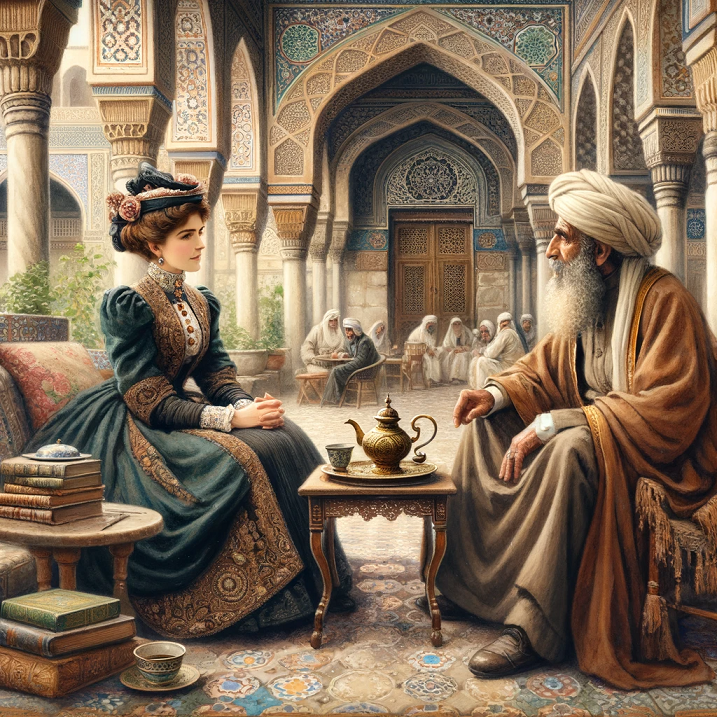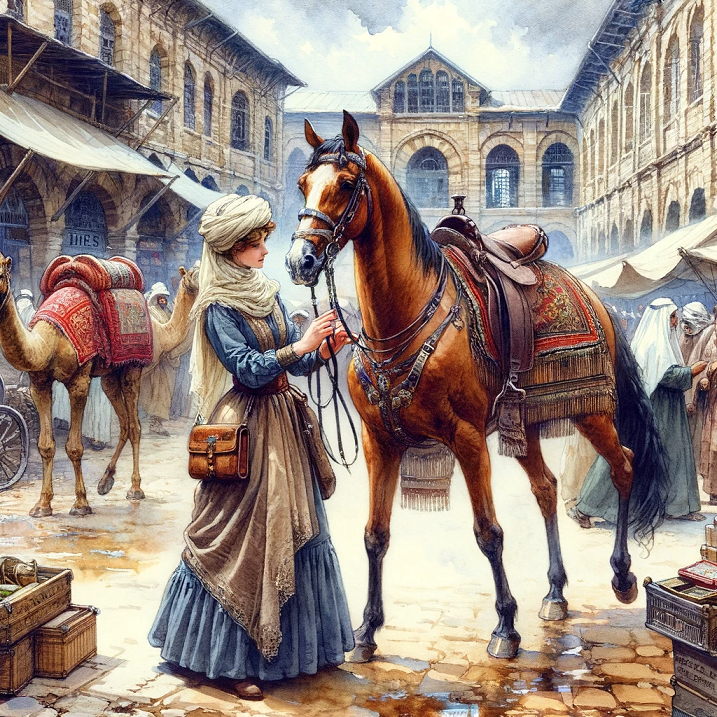In 19th-century travel literature, “A Pilgrimage To Nejd” by Lady Anne Blunt holds a distinctive place. This chronicle offers us a vivid window into her journey across the Arabian landscape. Lady Anne Blunt, alongside her companions, embarked on this daring expedition to Nejd, a region now part of Saudi Arabia, at a time when such travels were both rare and arduous, especially for Europeans and, more significantly, for a woman.
Key Takeaways:
- The tribal politics and dynamics in the Middle East play a critical role in the region’s socio-political landscape.
- The selection of camels and horses for the journey reflects Lady Anne Blunt’s deep engagement with local customs.
- Encounters with Abd el-Kader and Midhat Pasha showcase the diversity of leadership and ideologies in the Middle East.
- The Circassian refugee issue illustrates the complexities of ethnic integration and governance in the Ottoman Empire.
- Midhat Pasha’s reforms reveal the challenges of modernising in a traditional context, constrained by practical limitations.
The backdrop of Lady Anne Blunt’s journey was the Middle East of the late 19th century, a mosaic of cultures, tribes, and emerging political dynamics. This period was marked by a complex interplay of local tribal allegiances and the overarching influence of the Ottoman Empire. It was a time when traditional ways of life were beginning to feel the subtle pressures of modernity, yet the region remained deeply rooted in its centuries-old customs and social structures.
Lady Anne Blunt’s writings offer a unique perspective on the socio-political climate of the Middle East during this transformative era. Her observations, rendered with a blend of British sensibility and a deep respect for the cultures she encountered, make “A Pilgrimage To Nejd” an invaluable resource for understanding the historical context of the Arabian Peninsula during the late 19th century.
Transition from Europe to Asia
Lady Anne Blunt’s traversal from Europe to Asia marks a profound transformation in thought and perspective. As she steps into Asia, setting foot in Damascus on December 6, 1878, she notes a palpable change. The gloomy thoughts and tumultuous concerns that preoccupied her mind in Europe – political anxieties, social miseries, and the restless aspirations that are the legacy of “Japhet’s unquiet race” – seem to dissipate, replaced by a sense of tranquillity and presence.
The charm of the East is the absence of intellectual life there, the freedom one’s mind gets from anxiety in looking forward or pain in looking back. Nobody here thinks of the past or the future, only of the present; and till the day of one’s death comes, I suppose the present will always be endurable.
Lady Anne Blunt: A Pilgrimage to Nejd, The Cradle of the Arab Race
This transition is emblematic of the broader cultural and philosophical differences between the two continents. Europe, in the throes of industrialisation and political upheaval, presented a landscape of intellectual ferment and unrest. In contrast, Asia, or more specifically the Middle East, offered a realm where the mind was freed from such anxieties. The East, as perceived by Lady Anne Blunt, was marked by an absence of the intellectual tumult that characterised European life. It was a place where the past and the future held less sway over the minds of the people, who appeared more anchored in the immediacy of their daily lives.
Reunions & Relationships in Damascus
Upon her arrival in Damascus, Lady Anne Blunt’s journey takes on a more personal dimension as she reunites with familiar faces from her past travels. Key among them is Mohammed ibn Aruk, a companion from her previous year’s adventures, who had journeyed from Palmyra to meet her. This reunion underscores the bonds that Blunt had formed during her travels, transcending the usual constraints of culture and geography. Alongside Mohammed, she is greeted by Hanna, her courageous yet tearful cook, whose presence brings a sense of continuity and comfort to the expedition.
These reunions represent the intricate network of relationships and dependencies that underpin travel in this era. Each of these individuals, along with their accompanying friends or ‘relations‘ as they insist on calling them, plays a vital role in the logistics and success of Lady Anne Blunt’s journey. Their readiness to accompany her into the depths of Nejd speaks volumes about the trust and respect she had garnered among them.
Debate Over Servant Selection
A significant concern for Lady Anne Blunt and her party is the composition of their entourage, particularly the decision on whether to include Christian servants for the journey to Nejd. This debate is reflective of the complex social and religious fabric of the Middle East. The concern is not just about the practicalities of travel but also touches on deeper issues of cultural sensitivity and the potential risks involved in navigating a landscape where religious affiliation could have serious implications.
The selection of servants, thus, becomes a strategic decision, balancing the need for skilled and trustworthy individuals against the potential cultural and religious tensions their presence might provoke. This careful consideration of personnel highlights the challenges faced by travellers like Lady Anne Blunt in a region where religion and tribal affiliations played a critical role in every aspect of life.
Tribal Conflicts and Politics
Lady Anne Blunt’s narrative delves into the intricate tapestry of Middle Eastern tribal politics, a theme that forms a crucial backdrop to her journey. As she gathers news in Damascus, she learns of the latest developments in the desert: the sensation caused by her purchase of Beteyen’s mare and the ripples it sent through the tribal hierarchies. This incident not only highlights the importance of horses in Bedouin culture but also sheds light on the delicate balance of power and prestige among the tribes.
The dynamics among various tribes such as the Hamid, Sebaa, and Welled Ali are laid bare. Conflicts and alliances shift like sands in the desert; Faris and Jedaan, once at odds, now align, altering the power equations on the Euphrates. The tribal landscape is in constant flux, with loyalties and rivalries shaping the region’s socio-political milieu. Lady Anne Blunt, through her keen observations, provides a vivid account of these complexities, offering a glimpse into the Bedouin way of life where tribal affiliations dictate much of the social and political interactions.
Key Tribal Figures and Alliances
Central to the narrative are key figures such as Faris, Jedaan, and Mohammed Dukhi, whose actions and alliances significantly impact regional politics. Lady Anne Blunt’s account brings these characters to life, illustrating their influence and the roles they play in the broader tribal context. The alliances they form, the conflicts they engage in, and their strategic decisions are not just mere events but are emblematic of the broader themes of loyalty, honour, and survival in the desert.
Palmyrene Colony and Camel Selection
An intriguing aspect of Lady Anne Blunt’s preparations in Damascus involves her visit to the Palmyrene colony. This colony, consisting of a small community of families from Tudmur (Palmyra), represents a microcosm of the broader cultural landscape of the region. Her interactions are imbued with cultural exchanges and insights. The process of selecting camels, a critical component of her expedition, is detailed with an eye for both the practical and the anthropological.
In choosing camels, the principal points to look at are breadth of chest, depth of barrel, shortness of leg, and for condition roundness of flank. I have seen the strength of the hocks tested by a man standing on them while the camel is kneeling. If it can rise, notwithstanding the weight, there can be no doubt as to soundness.
Lady Anne Blunt: A Pilgrimage to Nejd, The Cradle of the Arab Race
The selection criteria for camels, emphasising aspects like breadth of chest and depth of barrel, reflect Lady Anne Blunt’s deep understanding and appreciation of the local customs and practical necessities. This meticulous attention to detail in choosing the camels underscores the challenges and realities of desert travel. The camels, described with an almost affectionate detail, are pivotal characters in her journey, integral to the success of her mission.
Choosing Horses
The selection of horses for the journey is another key element in Lady Anne Blunt’s preparations. The acquisition of a mare from Aleppo and the emphasis on breed and lineage highlight the cultural significance of horses in the Middle East. Horses are not just modes of transport but symbols of status, pride, and heritage. Her choice of a Ras el Fedawi and an Abeyeh Sherrak showcases her discerning eye and knowledge of Arabian equines.
The horses, much like the camels, are chosen with care and consideration, balancing practical needs with cultural and aesthetic values. Lady Anne Blunt’s familiarity with the traits and qualities of Arabian horses is evident in her choices, illustrating her deep engagement with the local culture and her understanding of the pivotal role these animals play in the Bedouin way of life.
We rode to the Maidan, and the chestnut’s good looks attracted general attention. Everybody turned round to look at her; she is perhaps too handsome for a journey.
Lady Anne Blunt: A Pilgrimage to Nejd, The Cradle of the Arab Race
Abd el-Kader: A Study in Character and Influence
One of the most compelling figures in Lady Anne Blunt’s narrative is Abd el-Kader, a character who embodies the fusion of religious piety, scholarly pursuits, and historical significance. Contrary to the common Western perception of him as a Bedouin Sheikh, Lady Anne Blunt paints a portrait of Abd el-Kader as a townsman and a priest, a man of letters and saintly disposition. His character is a fascinating study in the diversity and depth of Middle Eastern personalities.

Arabia proper, except in the first age of Islam and latterly during the hundred years of Wahhabi rule, has never been a religious country. Perhaps out of antagonism to Persia, its nearest neighbour, it neglects ceremonial observance, and pays little respect to saints, miracles, and the supernatural world in general. But with the Moors and the Algerian Arabs this is different. Their religion is the reason of their social life and a prime mover in their politics.
Lady Anne Blunt: A Pilgrimage to Nejd, The Cradle of the Arab Race
Abd el-Kader’s actions during the Damascus massacres, where he provided refuge to Christians, exemplify his broad-mindedness and humanitarian spirit. These acts of charity, coupled with his engaging discussions on Arab genealogy and traditions, reveal a man of profound wisdom and compassion. Lady Anne Blunt’s interactions with him offer insightful glimpses into the intellectual and spiritual life of Damascus, challenging and enriching her own understandings.
During the Damascus massacres he opened his doors to every fugitive; his house was crowded with Christians, and he was ready to defend his guests by force if need were.
Lady Anne Blunt: A Pilgrimage to Nejd, The Cradle of the Arab Race
Midhat Pasha: The Face of Reform and Administration
In stark contrast to Abd el-Kader stands Midhat Pasha, the Governor-General of Syria, representing the tides of administrative reform and modernisation sweeping through the Ottoman Empire. Lady Anne Blunt’s encounter with Midhat Pasha delves into the complexities of governing a land straddling tradition and change. Midhat, seen as a symbol of progress, speaks passionately about his plans for modernising Syria with steamers, tramways, and railways.
However, Lady Anne Blunt approaches Midhat’s ambitious plans with a degree of scepticism, shaped by her understanding of his previous administrative record in Baghdad. This interaction sheds light on the challenges of implementing Western-inspired reforms in a region deeply rooted in its own traditions and ways of life. Midhat’s vision of development, including his handling of the Circassian refugee problem, highlights the often-clashing ideologies of progress and tradition.
He had come with a considerable flourish of trumpets, for he was supposed to represent the doctrine of administrative reform, which was at that time seriously believed in by Europeans for the Turkish Empire. Midhat was the protégé of our own Foreign Office, and great things were expected of him.
Lady Anne Blunt: A Pilgrimage to Nejd, The Cradle of the Arab Race
The Circassian Refugee Problem
Amidst her exploration of the political and social landscape of the Middle East, Lady Anne Blunt encounters the complex issue of the Circassian refugees in Syria. This predicament, as presented by Midhat Pasha, encapsulates the broader challenges faced by the Ottoman Empire in managing displaced populations. The Circassians, uprooted and deported from their homeland following the Crimean War, had become a source of ongoing strife, highlighting the difficulties of integrating such communities into new environments.
These unfortunate refugees are, in truth, a problem not easy of solution : they have been a terrible trouble to Turkey, and, since they were originally deported from Russia after the Crimean war, they have been passed on from province to province until they can be passed no further. They are a scourge to the inhabitants wherever they go, because they are hungry and armed, and insist on robbing to get a livelihood. To the Syrian Arabs they are especially obnoxious, because they shed blood as well as rob, which is altogether contrary to Arab ideas.
Lady Anne Blunt: A Pilgrimage to Nejd, The Cradle of the Arab Race
Lady Anne Blunt notes the particular tension between the Circassians and the Syrian Arabs, exacerbated by differences in customs, particularly the Circassians’ propensity for bloodshed, which starkly contrasts with Arab norms. This situation paints a vivid picture of the challenges inherent in managing diverse ethnic groups within the Ottoman Empire’s vast and varied territories. The Circassian issue, as articulated in her narrative, serves as a microcosm of the empire’s larger struggles with modern governance and social cohesion.

In “A Pilgrimage To Nejd,” Lady Anne Blunt’s narrative serves as a rich tapestry of insights into the socio-political and cultural dynamics of the Arabian Peninsula in the late 19th century. Through her keen observations and vivid descriptions, she brings to life a world that, for many of her contemporaries, was shrouded in mystery and misconceptions.
FAQs:
Q: Who was Lady Anne Blunt?
A: Lady Anne Blunt was a 19th-century traveller who wrote about her journey to Nejd, in the Arabian Peninsula.
Q: What is the focus of “A Pilgrimage To Nejd”?
A: The book focuses on Lady Anne Blunt’s travels and observations of the Middle Eastern culture and political landscape.
Q: How does Lady Anne Blunt describe her transition from Europe to Asia?
A: She describes it as a shift from European anxieties to the peaceful present-mindedness of Asia.
Q: What significant figures does Lady Anne Blunt encounter in her journey?
A: She encounters Abd el-Kader, a revered priest and scholar, and Midhat Pasha, the Governor-General of Syria.
Q: What are some key themes in Lady Anne Blunt’s narrative?
A: Key themes include cross-cultural interactions, tribal politics, challenges of reform, and the Arab doctrine of patience.
Q: How does Lady Anne Blunt view the tribal politics in the Middle East?
A: She views them as complex and critical to understanding the region’s socio-political dynamics.
Q: What does the selection of camels and horses signify in her journey?
A: It signifies her respect for local customs and practical necessities of desert travel.
Q: What challenge does the Circassian refugee issue represent?
A: It represents the difficulty of integrating diverse ethnic groups in the Ottoman Empire.
Q: How does Lady Anne Blunt’s journey contribute to our understanding of the Middle East?
A: It offers a nuanced perspective on the historical, cultural, and political aspects of 19th-century Arabia.

